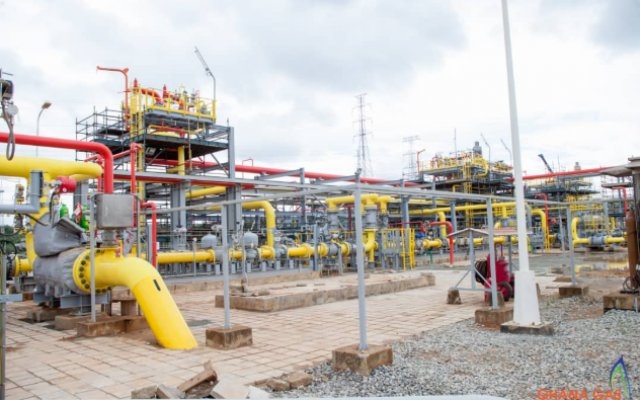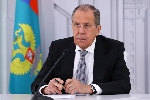WAGP – Ghana Gas pipeline ‘tie-in’ for ENI’s OCTP Gas: A stitch in time
Feature Article

Until recently, gas from offshore oilfields in the western coast of the country only terminated at the Aboadze thermal power enclave in the Western Region. Aside Ghana Gas having the capacity to deliver 150 million standard cubic feet per day (mmscf/d) for power generation, additional gas from Eni’s Offshore Cape Three Point (OCTP) Integrated Project was expected to deliver additional gas of close to 180 mmscf/d in mid-2018; thus moving the country’s natural gas volume close to 350 mmscf/d, which is beyond the daily requirement for the thermal units located in the western enclave.
As part of plans to fully evacuate the Eni gas, the Government of Ghana (GoG) signed a tie-in agreement with the West Africa Gas Pipeline (WAGP) in 2017 for the reverse flow of gas from the Western Region to the Tema power enclave, after the shareholders of WAGP declined Ghana’s proposal to purchase outright the over 250–kilometer Tema – Takoradi stretch of the pipeline system.
The inter-connection which was planned for the second quarter of 2018, was seen as a better alternative to the construction of a dedicated pipeline from Aboadze to Tema by the country, in terms of cost, social and environmental risks.
However, the failure to put in place appropriate off-take infrastructure for the gas from OCTP at least a year prior to the completion of the development and production from the Sankofa-Gye Nyame (SGN) fields per industry standard, forced some power plants to go idle for lack of natural gas, and costing the country about $28 million per month based on the Take-or-Pay clause enshrined in the OCTP Gas contract.
Background: OCTP Integrated Project
In late January 2015, GoG and the partners of the OCTP oil and gas fields signed the agreement to proceed with the OCTP Integrated Deep-water Project in Ghana.
The project was split into two stages: first the development of oil, then non-associated gas deposits. The entire project cost was estimated to reach $7.7 billion, with the World Bank supporting the project with a $500 million credit guarantee provided by HSBC and Standard Chartered Bank; for which the Ghana National Petroleum Corporation (GNPC) has twelve months to pay. There is also an escrow account funded by the GNPC with the equivalent of 4.5 months of gas sales ($205 million).
The development of the OCTP block is seen as being a major contribution to the country’s energy access, a pillar for enhancing Ghana’s balance of payments and powering the growth of the economy; with the World Bank describing the project as "top priority", as the long-term production of OCTP’s non-associated gas will underpin the growth of a domestic thermal power sector and accelerate Ghana’s industrial development.
Partners in the field include Eni Ghana the operator, with a 44.44% interest, while Vitol Ghana holds 35.56%, with the GNPC holding 20% on behalf of the GoG.
The OCTP license includes the combined development of the Sankofa Main, Sankofa East, and Gye Nyame as non-associated gas fields; Sankofa East Cenomanian and Sankofa East Campanian as oil fields. The fields are located within the OCTP block in the Tano Basin, in water depths of 600 – 1,000 meters, approximately 60km offshore of Western Ghana, and covering an area of approximately 694km². It is estimated to hold approximately 1.5 trillion cubic feet (tcf) of gas and approximately 500 million barrels (mmbbls) of oil in place.
The OCTP fields which were discovered between 2009 and 2012, is the first non-associated gas fields in Ghana, and the only deep-water non-associated gas development in sub-Saharan Africa in which the gas is fully committed to the domestic market for at least 15 years. The gas produced from the block was to enable country generate a minimum of 1,000 megawatt (MW) of power.
Development Plan for OCTP
The Plan of Development (POD) estimated the delivery of first oil in August 2017, peaking at 80,000 barrels per day (bbls/d) in 2019; while the first gas was initially expected to flow in February 2018 with a production rate of 180 mmscf/d.
The plan called for the installation of multiple wells and a subsea production system (SPS) connected via subsea umbilical, risers and flow-lines systems to a leased floating, production, storage and offloading (FPSO) vessel.
Gas from the fields was planned to be processed in the FPSO and transported through a 63km subsea pipeline to an onshore receiving facility (ORF) located near the village of Sanzule in the Western region of Ghana. Once onshore, the gas was meant to undergo further compression and injection into the Western Corridor (Ghana Gas) Pipeline and supplied to domestic industrial customers.
The crude oil from the other fields was to be processed, stored and offloaded directly offshore using oil tankers.
Aside the OCTP development plan, the Ministry of Energy (MoE) further undertook to improve the gas transmission system with compression stations and connections to industrial consumers, to complement the OCTP project.
Key Milestones
The receiving facility FPSO John Agyekum Kufuor built in Singapore, and meant to handle both oil and gas from the OCTP fields, arrived in the country in April 2017.
In May 2017 ENI launched oil production from the Integrated Oil and Gas Projects in just two and a half years, and three months ahead of schedule. By end 2017 the daily production of oil had reached 45,000 barrels. The accelerated ramp-up was as a result of the early start-up of the project.
Also the construction works of the onshore gas receiving facility and pipelines were 63% complete by mid-year 2017, and was expected to be fully operational in February 2018, and gas production plan was on course for 2018.
In early July 2018 and on schedule,production of non-associated gas started from two of the four Sankofa field deep-water subsea wells connected to the FPSO John Agyekum Kufour.
Gas flow to the onshore receiving facility in Sanzule was set after the final steps of commissioning of the Floating, Production, Storage and Off-loading vessel.
A Stitch in Time
Aside connecting the Ghana Gas pipeline which terminates at Aboadze to the WAGP from Nigeria as a reverse flow mechanism, the country had the relocation of the 470MW Karpowership from Tema to Takoradi as another option to have prepared to utilize the gas from the OCTP project.
And so the failure of GNPC to fully evacuate the gas when production commenced in early July 2018, triggered off the Take-or-Pay clause in the contract and cost the country some $28 million per month starting October 2018. And for the inability to evacuate all the gas produced, the GoG agreed that the production of GNPC’s share (20%) of the gas be deferred, leaving the gas in the ground for future utilization, and reducing the take-or-pay gas to 144 mmscf/d. An additional 60 mmscf/d was designated for power generation in the western enclave, thus further reducing the amount of gas unutilized to 84 mmscf/d.
But the inter-connection of the WAGP to the Ghana Gas pipeline in April 2019 to allow for the remaining unutilized gas to be used in Tema through the reverse flow mechanism, is a “stitch in time”; thus saving the country from continuous monthly payment to the OCTP partners for gas unutilized, the risk of payment default, power outages, and other dire consequences.
First; gas-fired thermal Plants within the Tema enclave could still have been deprived of the much needed and less expensive natural gas for power generation. And also because the reliance on liquid fuels and gas supply from Nigeria have proven to be expensive and unreliable, the consequence could have been extended power outages across the country.
Second; because the country’s power generation source is forced to tilt from thermal towards the Hydro source anytime the country has a challenge in meeting the fuel needs of the former, there was the likelihood of the Volta Lake’s (reservoir) integrity for subsequent years being compromised due to sharp draw-downs, and negatively affecting power supply.
Third; the country was also exposed to certain technical and geological risks that may in reality change the projected production levels, following government’s decision to re-inject GNPC’s share of the gas. This literally meant that the agreed volumes of natural gas the country was paying $28 million per month for cannot necessarily be produced at a much later date due to reservoir disturbance.
Fourth; should there be any payment short-fall under the Gas Sales Agreement (GSA), the sponsors would draw their payment from the Escrow Reserve Holding Account (ERHA) which the GNPC could only provide $100 million, as against the required $205 million as 4.5 months of estimated gas sales.
As a result, should the GoG fail to replenish the escrow account before it runs out, the World Bank’s credit guarantee could have been triggered. And that any default in payments to the partners by the Government could result in interest payments and eventually the degrading of the country’s credit rating should the $500 million credit guarantee be activated. A lower government’s credit rating may invariably have material consequences on access to funding market, funding cost, and collateral requirements.
Written by Paa Kwasi Anamua Sakyi, Institute for Energy Security © 2019
The writer has over 22 years of experience in the technical and management areas of Oil and Gas Management, Banking and Finance, and Mechanical Engineering; working in both the Gold Mining and Oil sector. He is currently working as an Oil Trader, Consultant, and Policy Analyst in the global energy sector. He serves as a resource to many global energy research firms, including Argus Media.
As part of plans to fully evacuate the Eni gas, the Government of Ghana (GoG) signed a tie-in agreement with the West Africa Gas Pipeline (WAGP) in 2017 for the reverse flow of gas from the Western Region to the Tema power enclave, after the shareholders of WAGP declined Ghana’s proposal to purchase outright the over 250–kilometer Tema – Takoradi stretch of the pipeline system.
The inter-connection which was planned for the second quarter of 2018, was seen as a better alternative to the construction of a dedicated pipeline from Aboadze to Tema by the country, in terms of cost, social and environmental risks.
However, the failure to put in place appropriate off-take infrastructure for the gas from OCTP at least a year prior to the completion of the development and production from the Sankofa-Gye Nyame (SGN) fields per industry standard, forced some power plants to go idle for lack of natural gas, and costing the country about $28 million per month based on the Take-or-Pay clause enshrined in the OCTP Gas contract.
Background: OCTP Integrated Project
In late January 2015, GoG and the partners of the OCTP oil and gas fields signed the agreement to proceed with the OCTP Integrated Deep-water Project in Ghana.
The project was split into two stages: first the development of oil, then non-associated gas deposits. The entire project cost was estimated to reach $7.7 billion, with the World Bank supporting the project with a $500 million credit guarantee provided by HSBC and Standard Chartered Bank; for which the Ghana National Petroleum Corporation (GNPC) has twelve months to pay. There is also an escrow account funded by the GNPC with the equivalent of 4.5 months of gas sales ($205 million).
The development of the OCTP block is seen as being a major contribution to the country’s energy access, a pillar for enhancing Ghana’s balance of payments and powering the growth of the economy; with the World Bank describing the project as "top priority", as the long-term production of OCTP’s non-associated gas will underpin the growth of a domestic thermal power sector and accelerate Ghana’s industrial development.
Partners in the field include Eni Ghana the operator, with a 44.44% interest, while Vitol Ghana holds 35.56%, with the GNPC holding 20% on behalf of the GoG.
The OCTP license includes the combined development of the Sankofa Main, Sankofa East, and Gye Nyame as non-associated gas fields; Sankofa East Cenomanian and Sankofa East Campanian as oil fields. The fields are located within the OCTP block in the Tano Basin, in water depths of 600 – 1,000 meters, approximately 60km offshore of Western Ghana, and covering an area of approximately 694km². It is estimated to hold approximately 1.5 trillion cubic feet (tcf) of gas and approximately 500 million barrels (mmbbls) of oil in place.
The OCTP fields which were discovered between 2009 and 2012, is the first non-associated gas fields in Ghana, and the only deep-water non-associated gas development in sub-Saharan Africa in which the gas is fully committed to the domestic market for at least 15 years. The gas produced from the block was to enable country generate a minimum of 1,000 megawatt (MW) of power.
Development Plan for OCTP
The Plan of Development (POD) estimated the delivery of first oil in August 2017, peaking at 80,000 barrels per day (bbls/d) in 2019; while the first gas was initially expected to flow in February 2018 with a production rate of 180 mmscf/d.
The plan called for the installation of multiple wells and a subsea production system (SPS) connected via subsea umbilical, risers and flow-lines systems to a leased floating, production, storage and offloading (FPSO) vessel.
Gas from the fields was planned to be processed in the FPSO and transported through a 63km subsea pipeline to an onshore receiving facility (ORF) located near the village of Sanzule in the Western region of Ghana. Once onshore, the gas was meant to undergo further compression and injection into the Western Corridor (Ghana Gas) Pipeline and supplied to domestic industrial customers.
The crude oil from the other fields was to be processed, stored and offloaded directly offshore using oil tankers.
Aside the OCTP development plan, the Ministry of Energy (MoE) further undertook to improve the gas transmission system with compression stations and connections to industrial consumers, to complement the OCTP project.
Key Milestones
The receiving facility FPSO John Agyekum Kufuor built in Singapore, and meant to handle both oil and gas from the OCTP fields, arrived in the country in April 2017.
In May 2017 ENI launched oil production from the Integrated Oil and Gas Projects in just two and a half years, and three months ahead of schedule. By end 2017 the daily production of oil had reached 45,000 barrels. The accelerated ramp-up was as a result of the early start-up of the project.
Also the construction works of the onshore gas receiving facility and pipelines were 63% complete by mid-year 2017, and was expected to be fully operational in February 2018, and gas production plan was on course for 2018.
In early July 2018 and on schedule,production of non-associated gas started from two of the four Sankofa field deep-water subsea wells connected to the FPSO John Agyekum Kufour.
Gas flow to the onshore receiving facility in Sanzule was set after the final steps of commissioning of the Floating, Production, Storage and Off-loading vessel.
A Stitch in Time
Aside connecting the Ghana Gas pipeline which terminates at Aboadze to the WAGP from Nigeria as a reverse flow mechanism, the country had the relocation of the 470MW Karpowership from Tema to Takoradi as another option to have prepared to utilize the gas from the OCTP project.
And so the failure of GNPC to fully evacuate the gas when production commenced in early July 2018, triggered off the Take-or-Pay clause in the contract and cost the country some $28 million per month starting October 2018. And for the inability to evacuate all the gas produced, the GoG agreed that the production of GNPC’s share (20%) of the gas be deferred, leaving the gas in the ground for future utilization, and reducing the take-or-pay gas to 144 mmscf/d. An additional 60 mmscf/d was designated for power generation in the western enclave, thus further reducing the amount of gas unutilized to 84 mmscf/d.
But the inter-connection of the WAGP to the Ghana Gas pipeline in April 2019 to allow for the remaining unutilized gas to be used in Tema through the reverse flow mechanism, is a “stitch in time”; thus saving the country from continuous monthly payment to the OCTP partners for gas unutilized, the risk of payment default, power outages, and other dire consequences.
First; gas-fired thermal Plants within the Tema enclave could still have been deprived of the much needed and less expensive natural gas for power generation. And also because the reliance on liquid fuels and gas supply from Nigeria have proven to be expensive and unreliable, the consequence could have been extended power outages across the country.
Second; because the country’s power generation source is forced to tilt from thermal towards the Hydro source anytime the country has a challenge in meeting the fuel needs of the former, there was the likelihood of the Volta Lake’s (reservoir) integrity for subsequent years being compromised due to sharp draw-downs, and negatively affecting power supply.
Third; the country was also exposed to certain technical and geological risks that may in reality change the projected production levels, following government’s decision to re-inject GNPC’s share of the gas. This literally meant that the agreed volumes of natural gas the country was paying $28 million per month for cannot necessarily be produced at a much later date due to reservoir disturbance.
Fourth; should there be any payment short-fall under the Gas Sales Agreement (GSA), the sponsors would draw their payment from the Escrow Reserve Holding Account (ERHA) which the GNPC could only provide $100 million, as against the required $205 million as 4.5 months of estimated gas sales.
As a result, should the GoG fail to replenish the escrow account before it runs out, the World Bank’s credit guarantee could have been triggered. And that any default in payments to the partners by the Government could result in interest payments and eventually the degrading of the country’s credit rating should the $500 million credit guarantee be activated. A lower government’s credit rating may invariably have material consequences on access to funding market, funding cost, and collateral requirements.
Written by Paa Kwasi Anamua Sakyi, Institute for Energy Security © 2019
The writer has over 22 years of experience in the technical and management areas of Oil and Gas Management, Banking and Finance, and Mechanical Engineering; working in both the Gold Mining and Oil sector. He is currently working as an Oil Trader, Consultant, and Policy Analyst in the global energy sector. He serves as a resource to many global energy research firms, including Argus Media.
Source: Emmanuel Mensah
Trending Features

Russia–Africa:New horizons for old friends
09:23
Justice for sale: When poverty becomes a barrier to the Rule of Law
10:13
Lithium: A billion-dollar mineral, a withdrawn bill, and a country at a crossroads
15:14
When silence speaks louder than words
12:12
Project finance: A viable path to build Ghana’s infrastructure without overstretching or overburdening public Debt Ghana is facing mounting fiscal and infrastructure financing pressures
10:24
As awareness campaigns fade, new HIV infections rise
09:48




